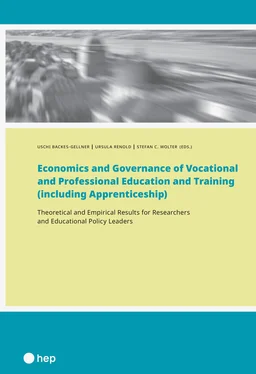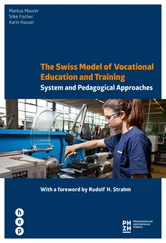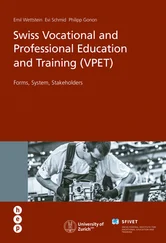Overall, results on the role of firms show that a favorable short- or long-term cost-benefit ratio for firms is a prerequisite for a well-functioning VET system and that apprenticeship wages, the ability to allocate apprentices to productive work, and the involvement of organizations representing firms’ interests in curriculum development processes help to ensure such a favorable cost-benefit ratio. Nonetheless, dual VET can be successful only if participation in apprenticeship training is also a favorable decision from the individual apprentices’ perspective because they (and their parents) are the ones who decide whether to begin their post-compulsory educational career with apprenticeship training.
Therefore, in Chapter 4, “ Individuals,” the book focuses on potential trainees, analyzing both the decision to start VET and the future career and labor market prospects of VPET graduates as compared with those of workers with other types of education. Young people choose (dual) VET if this type of education guarantees a good initial education, offers valuable educational career options, and leads to attractive short and long-term labor market outcomes. Like firms, individuals compare expected costs and expected benefits (both monetary and non-monetary) when deciding how to start and how to further develop their educational career paths.
The research presented in Chapter 4examines different decision points in an educational career and investigates factors affecting the students’ outcomes. The chapter covers the challenge of finding an apprenticeship position, successfully finishing VET, and having a smooth transition into the labor market. Results show that obtaining a contract for an apprenticeship position demands not only high cognitive skills and school grades but also other observable personal characteristics and non-cognitive skills.
In particular, individuals with the same directly and easily observable characteristics (e.g., gender or migration status) but with hard-to-observe personal characteristics (e.g., skills) are less likely to find an apprenticeship position ( Mueller & Wolter, 2014). After having found an apprenticeship position, apprentices face a new challenge—that of successfully completing their apprenticeship training. As firms use different incentive systems to reduce drop-out rates, apprentices respond to these incentives by adapting their behavior accordingly and are therefore more likely to successfully finish their apprenticeship training. For example, Oswald and Backes-Gellner (2014)show that financial bonuses that firms offer for better grades in VET school classes help increase the probability of students’ successfully finishing their apprenticeship training. They also show that these incentives have a particularly strong impact on impatient apprentices, those who have a low future-orientation and thus a comparatively high ex ante risk of dropping out.
After successfully finishing VET, the next challenge for the former apprentices is a smooth transition to the labor market. In analyzing this transition, Bertschy, Cattaneo, and Wolter (2009)conclude that VET as a whole provides individuals a good start in the labor market. Both the successful completion of apprenticeship training and the student’s achievements during apprenticeship training are important in facilitating a smooth transition to the labor market. Although school performance at the end of compulsory schooling has no direct effect on labor market entry, it does have an indirect effect: Individuals with a good school performance are more likely to receive more demanding VET positions, and graduates of demanding VET occupations are more likely to have a smooth transition to the labor market.
As to long-term labor market outcomes, the research in this book has analyzed the importance of both the possibility of educational upgrading and the permeability of the two-pathway education system. Individuals starting out with a VET education have the option of either obtaining a professional education (PET) or to switching to an academic education. As a result, individuals starting with VET degrees have comparable—and in some respects even more favorable—labor market outcomes to individuals starting out with an academic education. On average, vocational education is associated with a low unemployment risk, good wage prospects for the individual’s entire working life, and relatively low wage risk ( Backes-Gellner & Geel, 2014; Tuor & Backes-Gellner, 2010). However, given that returns differ substantially over the wage distribution ( Balestra & Backes-Gellner, 2017) no particular educational path provides the one best solution for all individuals. Instead, individual preferences and talents influence the educational decision.
The results in Chapter 4also show that one important factor in determining particularly long-term labor market outcomes is the chosen occupation. Although the traditional education literature assumes that VET education is very specific (as compared to academic education, which the literature assumes to be general), the results in this chapter show that VET is not specific per se ( Eggenberger, Rinawi, & Backes-Gellner, 2018). Instead, occupations can be more and less specific, depending on the bundle of skills learned in one occupation compared to the bundle of skills required on the external labor market. Empirical results such as those in Geel, Mure, and Backes-Gellner (2011)show that an occupation’s degree of specificity determines both occupational mobility and the risks and returns associated with training in that occupation. Geel and Backes-Gellner (2011)also show that mobility within skill clusters or clusters of occupations with similar skill combinations is not only possible but actually high.
Thus, educational policy makers and those who design occupational curricula should not only look at skill relevance within each occupation but also ensure that a single occupation is well positioned within the overall spectrum of occupations and their respective skill bundles. Therefore, VET researchers need to place a new focus on digital and IT skills due to the rapid development of digital technologies. Ongoing research by Eggenberger and Backes-Gellner (2020)indicates that the distinction between different types of IT skills is important—for example, the difference between generic IT skills that are complementary to and productivity enhancing in all skill bundles and expert IT skills that are only used, and therefore helpful, in very specific skill combinations. Generic IT skills improve mobility and long-term labor market outcomes, whereas specific expert IT skills increase specificity and returns in the training occupation but reduce mobility and its returns. These and the other results in this chapter show that substantial risk-return trade-offs exist in the design of occupational curricula and that individuals can and should choose their occupations depending on their individual risk profiles.
Either way, the success of a VPET system depends on attractive educational options for those who start their career with a VET degree. These options include, first, VET degrees and subsequent educational pathways providing attractive initial employment, career options, and equal social status; second, occupational curricula defined so that they allow for sufficient occupational mobility; and third, an education system that guarantees permeability between different types of educational career paths with educational upgrading opportunities for all.
In Chapter 5, “ State and Institutional Frameworks,” this book investigates the role of the state, national regulations, social and economic institutions, and cultural differences and their roles for the functioning of VPET systems. The state—typically represented by one or several ministries or government agencies—regulates the education system based on a more or less elaborate legal framework. However, as dual VET is not only part of the education sector but also part of the employment system, Chapter 5also investigates institutions and regulations with coordinating functions between the two sides (e.g., professional organizations, unions, or chambers of commerce and industry).
Читать дальше












